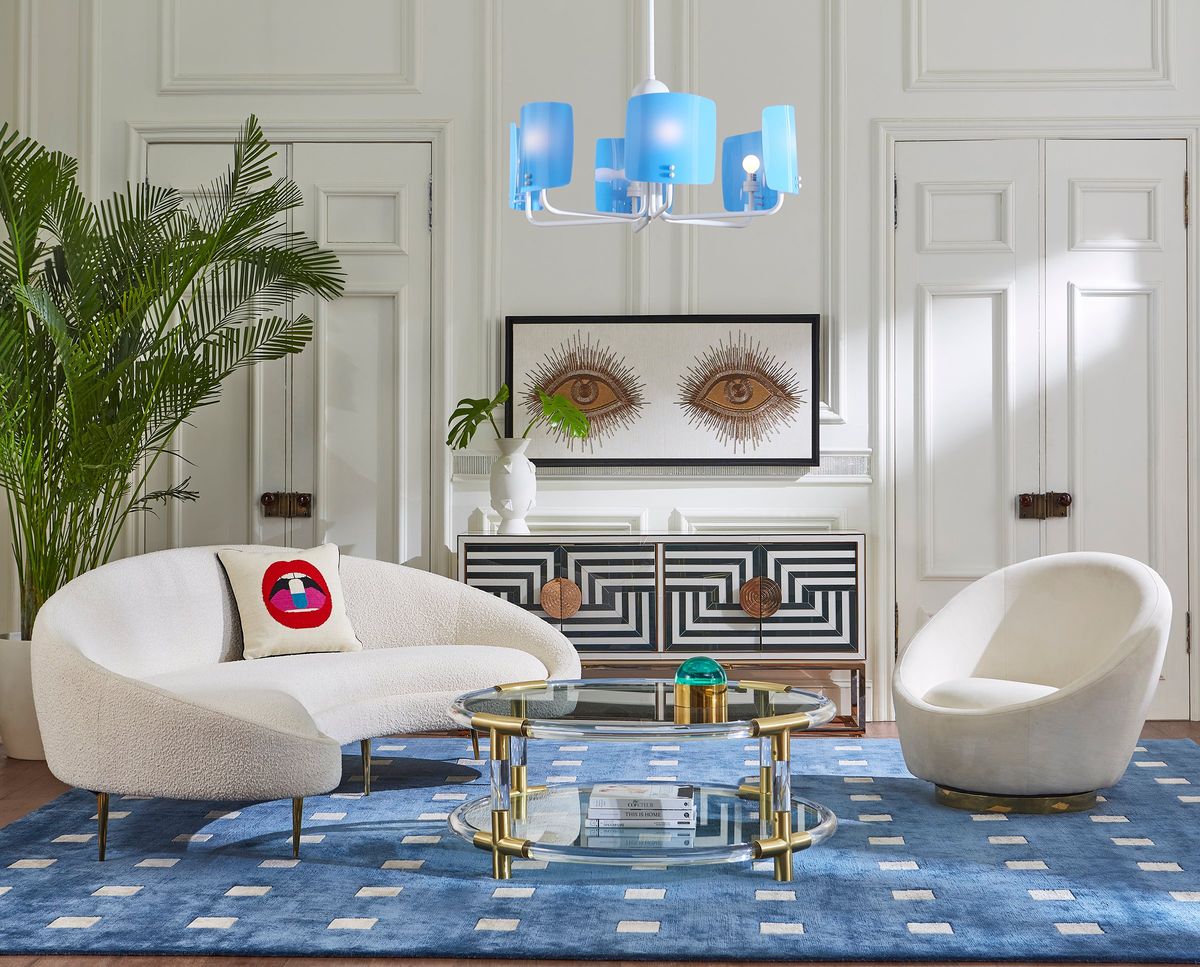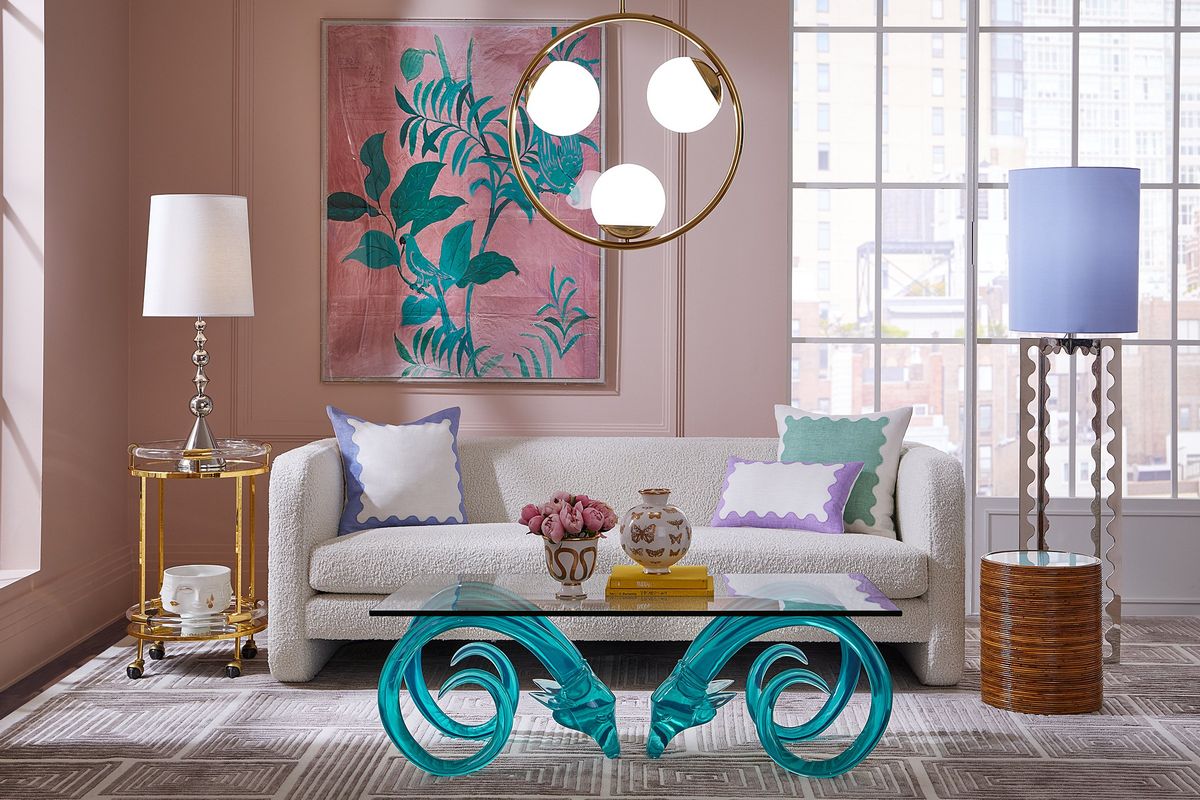Designer Jonathan Adler on how to find your decorating style
Jonathan Adler likes the way the light glimmers through his Aries cocktail table, which is made with two acrylic rams under a glass tabletop. His sculptural Ripple floor lamp features a shiny nickel base and a powder-blue shade. (Courtesy of Jonathan Adler)
Potter, designer and author Jonathan Adler’s career is full of creative highlights, including designing swanky hotels, being a judge on HGTV’s “Design Star: Next Gen” and creating a real-life Malibu Barbie Dream House. His furniture, pillows, rugs and vases are sold throughout the world, including at 11 Jonathan Adler stores, and he recently launched his first collection of tiles for Lunada Bay.
His latest gig is a 13-episode instructional series, “Decorate Like a Designer, with Jonathan Adler,” which premiered in May on Wondrium, a subscription streaming service for educational content. “I have spent my life thinking about how design works,” says Adler, 55. “I felt it was time to share what I know.”
The show’s topics are wide-ranging: lighting, accessorizing, salvaging old objects, color, the magic of repetition – and a compelling lesson on the history of design over the past 100 years. (He even shows viewers how he makes a pot.) It’s a well-organized introduction to the basic principles of design for anyone who wants to improve their skills and for young designers looking to learn from a seasoned pro.
Caution, though: Do not watch all 13 episodes in one day. (I speak from experience here.) It could leave you muttering the series’s mantra, “glamour equals swagger,” in your sleep.
We caught up with Adler last week in a phone interview from the Shelter Island, N.Y., home that he shares with his husband, fashion guru Simon Doonan, who also appears in the Wondrium series. (The two also have a home in Palm Beach, Florida.) We asked Adler to share advice on finding your own style.
How do you explain to people how to find their own style?
I like to explain how I come to my own style. There are three filters through which I see the design world, three voices that wend their way into all of my work, from objects to furniture to decorating: pop, natural and deluxe. Pop is about bright, bold, minimalist, somewhat cheeky voices and muses like Andy Warhol and Ellsworth Kelly and is an opportunity to be witty and artistic. Natural comes from the fact that I am an artisan and that I believe in impeccable materials and honest, timeless craft. And deluxe is more luxury. [In the Wondrium lesson, he mentions velvet, sparkles, gold and chinoiserie.] I hope that one of these styles will resonate or that people will create their own personal, idiosyncratic style.
Where can people find designers and tastemakers to inspire them?
The holy trinity for me: Pinterest, Instagram and 1stDibs. I am transported by Pinterest. It almost makes me comatose, and I lose track of time and space. The company 1stDibs is great, because it breaks things down by designer. If you like someone’s objects and furniture, then you can see everything that person has done. This is a great way to get a sense of design history and context.
Can your clothes be an indication of what style you like in your home? [Adler’s uniform is white jeans year-round and Stan Smiths.]
In an ideal world, your sartorial and decorating styles would be the same. I often see women who look very groovy and chic and edgy, and I imagine them living in a minimalist, art-filled home, but then I get there, and it’s a cabbage rose English country cottage look. Sometimes there is a complete dissonance between someone’s sartorial and decorating styles. It’s a lot easier to change your clothes than your decor. Decor is often a snapshot of where someone was, and clothes are more the now, so it doesn’t always work.
How do you decide whether you are a minimalist or maximalist?
You have to really think about what makes you happy at home. Are you a person who loves to have one handbag you use every day, or do you need 10? Although people might not think that I’m a Marie Kondo guy, I have learned that I only keep pieces around me that spark joy. (I just happen to have a lot of them.) I am a minimalist/maximalist. I try to keep it sleek and modern and elegant and clean-lined. Design should be a process of paring things down to be clear and to communicate, but you can still end up with a lot of items.
How do crafty pieces you’ve made fit into your decor?
If objects have personal meaning and history, then they are worth displaying. There is an incredibly profound and life-affirming feeling that comes from making something. I am very nonjudgmental and very anti-snobbism. Not everything needs to be expensive, and it should not be about what other people think. It’s about stuff at home that will make you happy. It’s about finding your voice, not a trendy voice.
How do you find the colors that are really you?
My people think of me as a very colorful character. I am actually a lot more restrained in my use of color than people might think. I would follow my lead and go to timeless, forever colors such as black and white, which are in the foundation of everything I do. Then you inject an accent color in smaller items such as pillows and accessories. This can be a go-to formula for creating design that will be lasting and not too ephemeral. The colors you consider should stick around for a while and be more restrained in larger pieces and freer in smaller ones.


